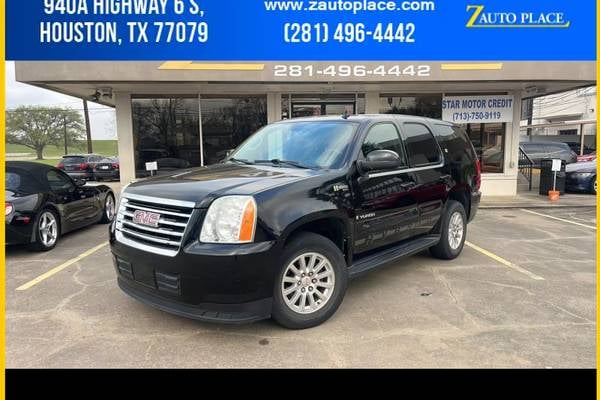2008 GMC Yukon Hybrid Review
Price Estimate: $5,382 - $8,215
 View 41 more photos
View 41 more photos View 41 more photos
View 41 more photos View 41 more photos
View 41 more photos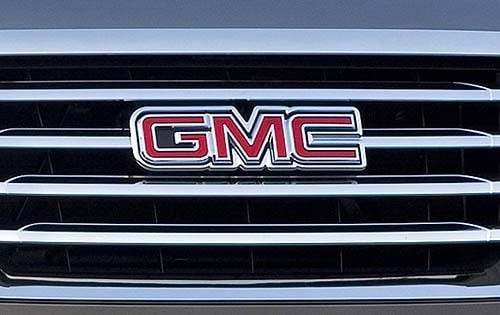 View 41 more photos
View 41 more photos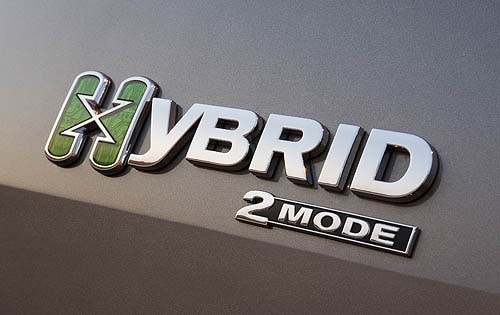 View 41 more photos
View 41 more photos+37
Edmunds' Expert Review
by the Edmunds Experts
Pros
- Significant fuel economy advantage versus regular Yukon, handsome cabin with fine build quality, comfortable ride, seats eight passengers.
Cons
- Third-row seat doesn't fold flat and must be removed, fuel economy still not much better than some crossovers, hefty price premium.
What’s new
The 2008 GMC Yukon Hybrid is the first full-fledged hybrid model produced by General Motors. It is based on the Yukon full-size SUV that was redesigned last year.
Edmunds says
Although the merits of a full-size hybrid SUV can be debated, the 2008 GMC Yukon Hybrid is a successful first application of GM's new Two-Mode technology and a worthy addition to the Yukon lineup.
For sale near Des Moines, IA
3 listings
- 114,449 miles
- No accidents, 1 owner, personal use only
- 8 Seats, 21 City / 22 Hwy MPG
- Z Auto Place (826 mi away)
- Back-up camera
- Navigation
- Leather Seats
- Sunroof/Moonroof
- Third-row seating
Close
Located in Houston, TX
AutoCheck Vehicle History Summary
Accident Free Vehicle: Yes
Personal Use Only: Yes
History Provider: AutoCheck
Title Details: Clean Title
Salvage Vehicle: No
Frame Damage: No
Theft History: No
Lemon Status: No
Free History Report: No
Features and Specs:
21 Combined MPG (21 City/22 Highway)
Listing Information:
VIN: 1GKFC13528R228057
Stock: 228057
Certified Pre-Owned: No- 189,245 miles
- No accidents, 5 owners, personal use only
- 8 Seats, 21 City / 22 Hwy MPG
- J-Linn Motors (1,122 mi away)
- Back-up camera
- Navigation
- Leather Seats
- Third-row seating
- Power Driver Seat
Close
Located in Clearwater, FL
AutoCheck Vehicle History Summary
Accident Free Vehicle: Yes
Personal Use Only: Yes
History Provider: AutoCheck
Title Details: Clean Title
Salvage Vehicle: No
Frame Damage: No
Theft History: No
Lemon Status: No
Free History Report: No
Features and Specs:
21 Combined MPG (21 City/22 Highway)
Listing Information:
VIN: 1GKFC13548R206898
Stock: 206898
Certified Pre-Owned: No
Listed since: 05-02-2025
Vehicle overview
Purchasing an earlier General Motors hybrid model could perhaps be equated to buying tickets to see Kiss, only to discover it's actually a tribute band made up of four guys from Ann Arbor. While GM's models like the Saturn Vue Green Line may have worn hybrid regalia, their gasoline-electric technology was unsophisticated and underpowered compared to "full" hybrids from Toyota and other carmakers. With its all-new Two-Mode hybrid technology, the 2008 GMC Yukon Hybrid is the real Gene Simmons deal. A new approach to hybrid design helps create a full-size SUV that gets fuel economy in the 20s, carries eight people and tows 6,000 pounds.
At the heart of the Yukon Hybrid is the "Two-Mode" technology co-developed by GM, BMW and DaimlerChrysler. Completely understanding the differences between this two-mode system and other "full" hybrid systems basically requires an engineering degree, so if you couldn't care less how it works, skip the next two paragraphs.
As with a regular Yukon, you'll find a V8 under the hood. But this 6.0-liter V8 has cylinder-deactivation technology (it turns a V8 into a V4 when full power isn't needed) and is supported by a pair of 60-kilowatt motors packaged within the transmission to provide the electric motivation. Dubbed an electrically variable transmission (EVT), it features those two motors, three planetary gearsets and four traditional hydraulic wet clutches.
The EVT is essentially like having two transmissions inside one -- continuously variable drive for light load conditions and fixed-ratio for high load conditions. Hence two-mode. The hybrid system then constantly receives data from the powertrain and other vehicle systems to determine the most fuel-efficient means of propelling the vehicle -- be it electric power, gasoline power or a combination of the two. And like other hybrid models, there's a battery pack for storing power, regenerative braking to take advantage of momentum, and the ability to shut off the engine when the vehicle is stopped.
For those who skipped ahead, welcome back. The moral of the above story is that a 5,600-pound full-size SUV returns fuel economy better than most large crossovers. City mileage is particularly impressive, and like most hybrids, is about equal to highway mileage. This is the result of being able to accelerate up to approximately 25 mph using electricity only, a fuel-saving asset on surface streets and in stop-and-go traffic. If that's your driving domain, the Yukon Hybrid makes a lot of sense.
In addition to improved fuel economy, the 2008 GMC Yukon Hybrid boasts more power than its gas-only brother. However, don't expect much better acceleration, as the hybrid tips the scales at a hundred or more pounds heavier than a fully loaded Yukon. That's despite GM's best efforts to cut weight by constructing several body panels of aluminum and trimming heft from the seats (though ironically not from the heavy removable third-row seats, which could use a nip and tuck).
Other than its sophisticated running gear, the Yukon Hybrid is essentially a fully loaded Yukon SLT. The only options are a sunroof and DVD entertainment system, with niceties like leather, a rearview camera and navigation system standard. However, the price premium is significant, ringing in at about $8,000 more than a similarly equipped gas-only Yukon. (It's also about $900 more expensive than its Chevy Tahoe sibling without offering anything extra aside from GMC's "Professional Grade" slogan.) Although the fuel economy difference is also commendable, it will take a lot of miles/years for your gas savings to justify the out-the-door premium. We'll let you decide if the environmental benefits are worth the price, but how green can a 5,600-pound SUV really be?
So, unless the 2008 Yukon Hybrid's significant towing capabilities are important, a full-size crossover like the GMC Acadia may be a better choice. It provides more usable passenger space, is friendlier to drive, gets close to the same fuel economy and is $8,000 cheaper when loaded to the gills. The new two-mode hybrid system is certainly impressive, but we're not entirely sure if the Yukon is the right vehicle for it.
Performance & mpg
The 2008 GMC Yukon Hybrid is available with rear-wheel or four-wheel drive. Both models utilize a 6.0-liter V8 engine coupled to a pair of 60-kilowatt electric motors located inside what GM calls an electrically variable transmission. Together they produce 332 horsepower and 367 pound-feet of torque. The system can accelerate the Yukon up to speeds of approximately 25 mph using electricity only, while the V8's cylinder-deactivation system helps reduces fuel consumption at higher speeds. Regenerative braking replenishes the batteries by capturing energy normally lost when coming to a stop. Fuel economy is 21 mpg city and 22 mpg highway for rear-wheel-drive Yukon Hybrids and 20/20 with four-wheel drive. Maximum towing capacity for a properly equipped 4WD model is 6,000 pounds.
Safety
Standard safety equipment includes full-length side curtain airbags, antilock disc brakes, traction control, OnStar and a rearview camera. In government crash testing, the Yukon Hybrid scored a perfect five stars in all frontal and side impact tests.
Driving
It's not a stretch to say that driving the 2008 GMC Yukon Hybrid feels like being behind the wheel of a 5,600-pound Prius. There's the same eerie quiet when accelerating and braking, as the gas engine shuts off to let the electric motors do their thing. Although a tad strange, the result is a quiet cabin, while transitions between gas and electric modes, and eight- and four-cylinder mode, are either undetectable or easy to ignore.
The regenerative braking system produces a firm braking feel and, according to GM, actually stops the big SUV better than the regular Yukon's conventional brakes do. Although the Hybrid is the most powerful Yukon available, it's also the heaviest, so don't expect particularly brisk acceleration. Still, its abundance of low-end power -- aided by those torque-rich electric motors -- produces plenty of "motorvation" for around-town chores and trailer towing.
Interior
Aside from instrumentation, there's nothing to distinguish the Yukon Hybrid from a traditional Yukon. Unlike in past generations, that's a very good thing. The newest Yukon boasts attractive, high-quality materials and tight panel gaps while maintaining a simple control layout. Even the standard navigation system is easy to use.
With its standard third row, the Yukon can seat up to eight passengers. Unfortunately, that 50/50 third row does not fold flat into the floor. Since the two seats weigh slightly less than a Geo, you'd better have Steve Austin on standby to help remove them. Once they're out, though, maximum cargo capacity is a whopping 109 cubic feet with the folding second row down -- much more than any other hybrid offers.
2008 GMC Yukon Hybrid models
The 2008 GMC Yukon Hybrid is a full-size SUV available in one trim level. Standard equipment includes 18-inch alloy wheels, rear parking assist with rearview camera, tinted windows, power-folding heated side mirrors and tri-zone automatic climate control. A trip computer, an auto-dimming rearview mirror, remote ignition, leather upholstery, power front seats and a removable 50/50-split third-row seat are also standard. In-car entertainment includes a navigation system, a hybrid system display and a nine-speaker Bose audio system with CD/MP3 player, auxiliary audio jack and satellite radio. A sunroof and rear-seat DVD entertainment system are the lone options.
Compare 2008 GMC Yukon Hybrid trim levels
Helpful trims summary and side-by-side comparison chart
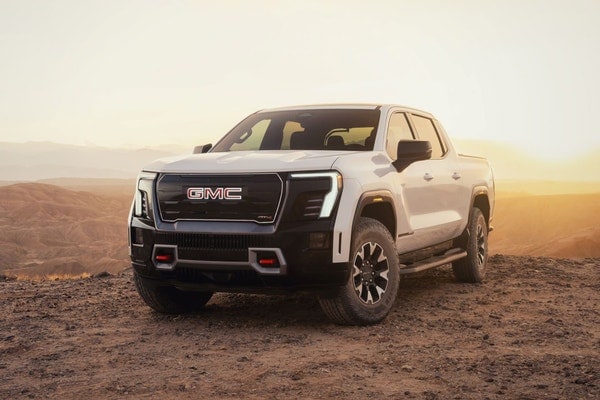
2026 GMC Sierra EV AT4 First Drive: Taking the Electric Pickup Off-Road
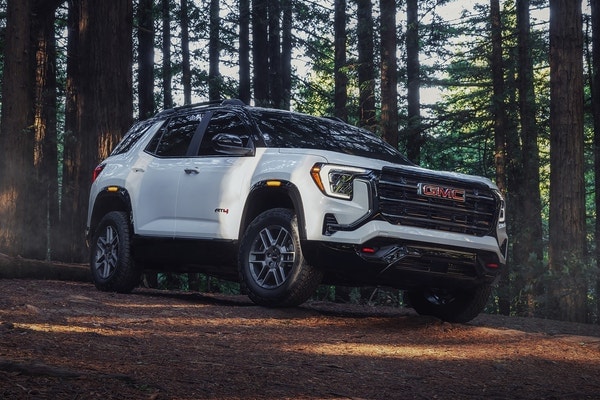
2026 GMC Terrain First Drive: Stretching Upmarket
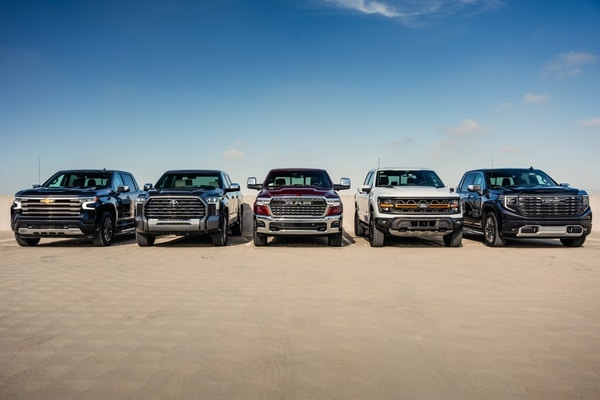
Ford F-150 vs. Chevy Silverado vs. GMC Sierra vs. Ram 1500 vs. Toyota Tundra: Every Full-Size Truck Compared

GMC Sierra EV Adds Less-Expensive AT4 and Elevation Trims for 2026
Cost to Drive
Monthly estimates based on costs in Iowa
$173/mo for Yukon Hybrid Base
Yukon Hybrid Base
vs
$220/mo
Avg. Large SUV
GMC Yukon Hybrid Owner Reviews
Most Helpful Owner Reviews
Trending topics
No buyer's remorse here!
4.88 out of 5 starsTex, 07/30/2010
2008 GMC Yukon Hybrid 4dr SUV (6.0L 8cyl gas/electric hybrid 4A)
After the Hybrid stickers were removed, my family and I stand back and admire the beauty of this automobile. We had been persuaded away from American-made cars several years ago and went the way of the foreign minivan. We were leery of Government Motors, but are extremely happy with the quality of this vehicle. The ride is smooth, the gas mileage is really 20 mpg, and the cargo room … is expansive with the last row of seats out. All our stuff can fit and when the grandparents come to town, everyone has ample room. GM did a great job without sacrificing anything. It's solid and the quality is on par with any Toyota/Honda/Nissan minivan out there!
The Yukon Hybrid is it
5 out of 5 starsJason, 03/14/2008
2008 GMC Yukon Hybrid 4dr SUV 4WD (6.0L 8cyl gas/electric hybrid 4A)
I've only been driving the Yukon Hybrid for about two weeks now, and I must say bravo for GM. It's so quiet, you barely hear it coming. The hybrid drive shift's so smooth you cant feel it shift.
dont buy! you've been warned!
1 out of 5 starsysaac, 08/18/2016
2008 GMC Yukon Hybrid 4dr SUV (6.0L 8cyl gas/electric hybrid 4A)
bought it used with over100k, and after $4000 of repairs it is still staling and having acceleration issues, now dealer says i need new battery and transmission ! $8000! going to buy an f150 with that money ...use it for down...never more with gmc/chev!
dont buy!
1 out of 5 starsYsaac, 09/24/2016
2008 GMC Yukon Hybrid 4dr SUV (6.0L 8cyl gas/electric hybrid 4A)
thought it was the best thing next to sliced bread, but what a headache this suv has been! burns oil due to bad engineering of the AFM system, dealer just gives run around, when you force them to repair it will cost you big! maybe even a new engine, read post about this vehicle before you think of buying, mine took a crap at around 110k miles so i was out of luck with warranty...also mpg … is really round 16mpg avg. so not worth the extra thousands of dollars diff. from a regular yukon! thats why GM stop making them. got an F150 now, loved my Jimmy but they made me hate it! due to design flaw and lack of support bye GMC!
2008 Yukon Hybrid Highlights
| Base MSRP Excludes Destination Fee | $50,045 |
|---|---|
| Engine Type | Hybrid |
| Combined MPG | 21 MPG |
| Cost to Drive | $173/month |
| Seating | 8 seats |
| Cargo Capacity All Seats In Place | 16.9 cu.ft. |
rear wheel drive | |
| Warranty | 3 years / 36,000 miles |
Safety
Key safety features on the Yukon Hybrid include:
- Back-up camera
- Tire Pressure Warning
- Stability Control
- Post-collision safety system
NHTSA Overall Rating
The National Highway Transportation Safety Administration offers independent analysis.
- Frontal Barrier Crash RatingOverallNot RatedDriver5 / 5Passenger5 / 5
- Side Crash RatingOverallNot Rated
- Side Barrier RatingOverallNot RatedDriver5 / 5Passenger5 / 5
- Combined Side Barrier & Pole RatingsFront SeatNot RatedBack SeatNot Rated
- RolloverRolloverNot RatedDynamic Test ResultNo TipRisk Of RolloverNot Rated
Related Used 2008 GMC Yukon Hybrid info
Vehicle reviews of used models
- GMC Canyon 2021 Review
- Toyota C HR 2021 Review
- Hyundai Kona 2021 Review
- Chevrolet Blazer 2020 Review
- Audi Q8 2020 Review
Shop used vehicles in your area
- Honda Fit Car
- I3 BMW
- Lexus NX 300H Awd
- Used Acura ILX 2013
- Used Acura ILX 2015
- Used Acura ILX 2016
- Used Acura ILX 2017
- Used Acura Integra 2014
- Used Acura Integra 2019
- Used Acura Integra 2020
Popular new car reviews and ratings
- BMW ALPINA XB7 2026
- 2026 Carnival
- New BMW 4 Series
- Jeep Wagoneer S 2025
- 2024 GMC Savana Cargo
- 2025 GMC Savana Cargo News
- 2025 Mercedes-Benz EQS
- 2026 Chrysler Town and Country News
- New Lexus LS
- 2024 GV80
Research other models of
- New GMC Sierra 2500HD
- 2025 GMC Sierra 2500HD
- GMC Sierra 1500 2024
- 2025 GMC HUMMER EV SUV
- 2025 Sierra 1500
- 2024 Sierra 1500
- 2024 GMC HUMMER EV
- 2025 GMC Sierra 3500HD
- GMC Sierra 3500HD 2024
- New GMC Yukon XL
Other models
- Used Suzuki Reno in San Bruno, CA 2008
- Used Chrysler Pacifica in Montgomery, TX 2025
- Used BMW M5 in Levittown, NY 2026
- Used Hyundai Ioniq-Plug-In-Hybrid in Texarkana, AR 2022
- Used Lexus Ux-250H in Reading, PA 2023
- Used Lexus LX-470 in Mount Pleasant, TX 2007
- Used Acura Tsx-Sport-Wagon in Stafford, VA 2014
- Used Mercury Milan in Thousand Oaks, CA 2011
- New Toyota Land-Cruiser for Sale in Decatur, GA
- Used Chevrolet Equinox-Ev in East Northport, NY 2025
